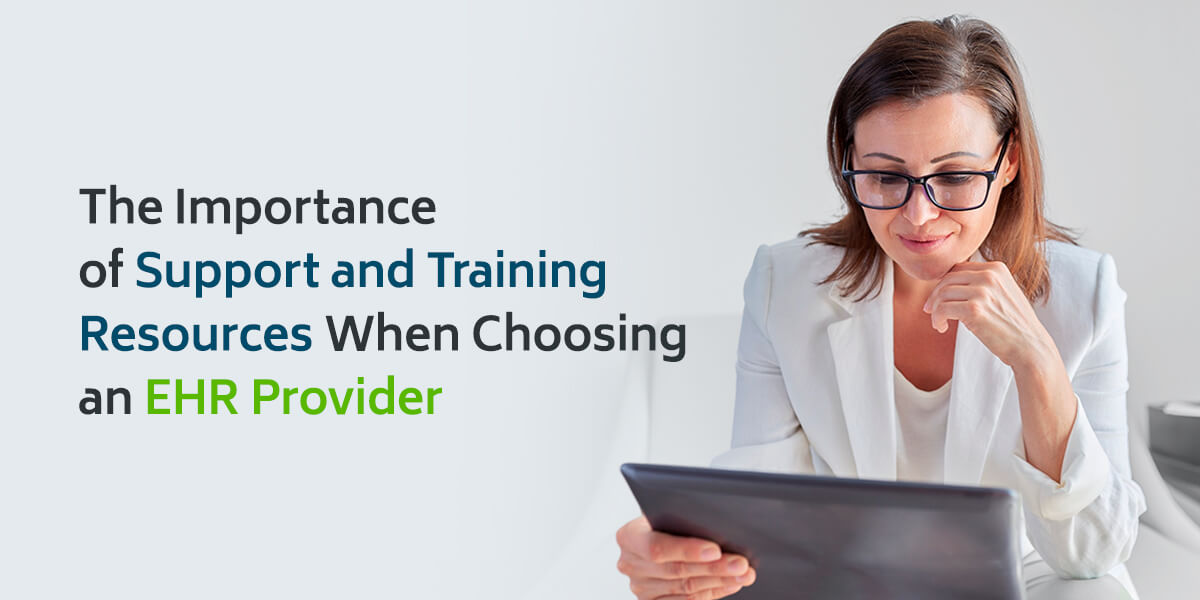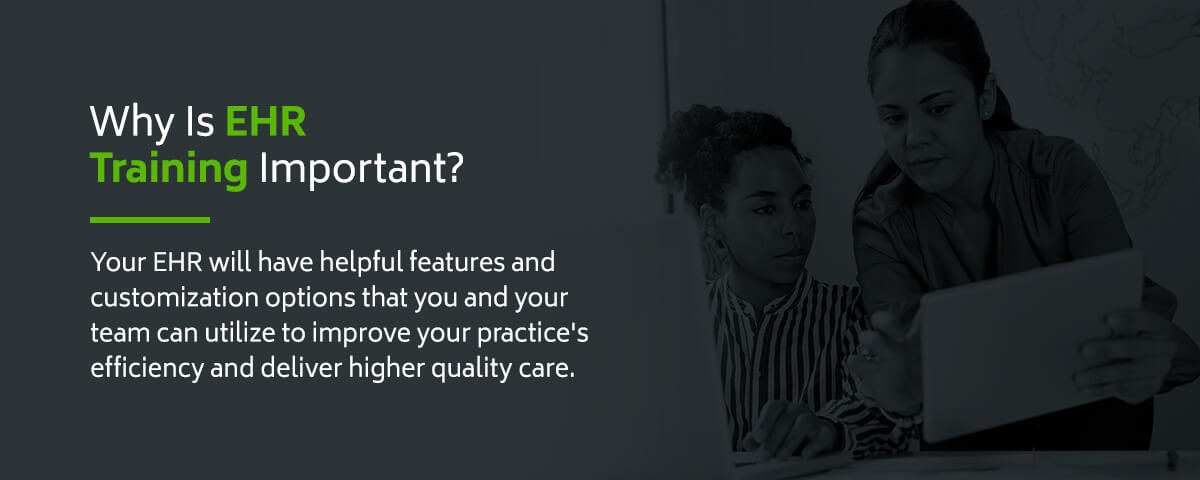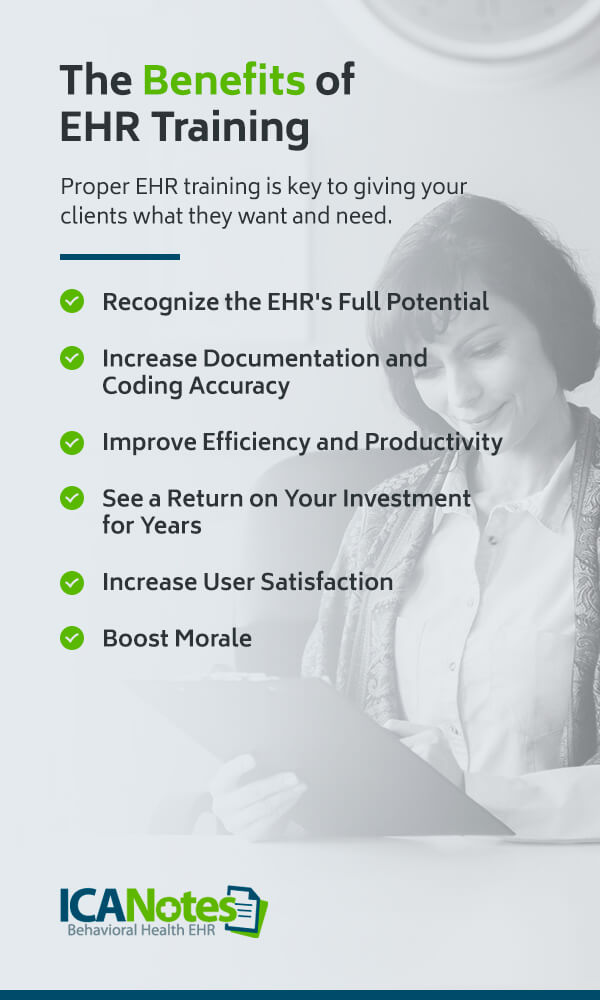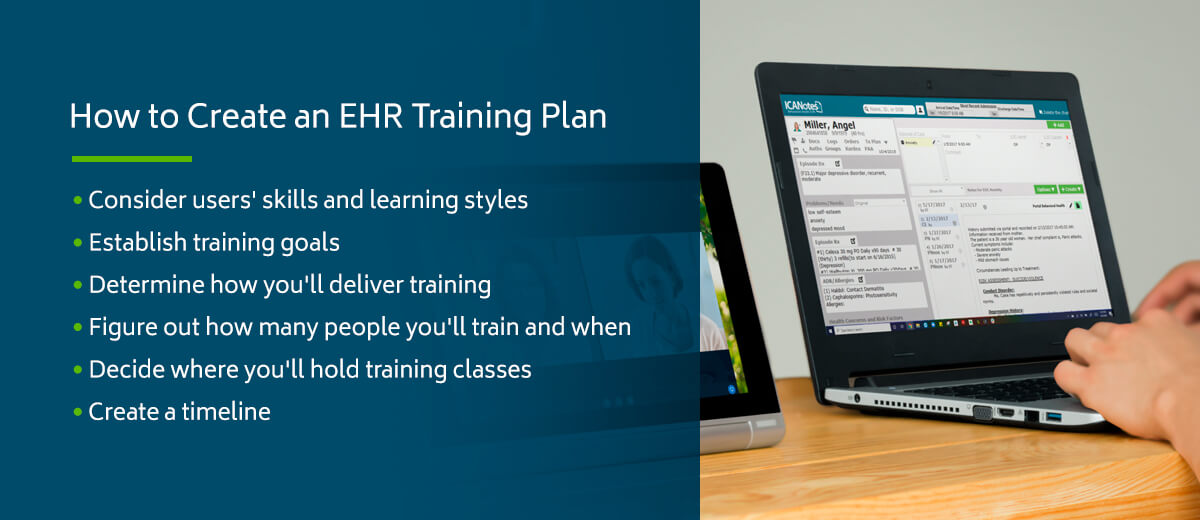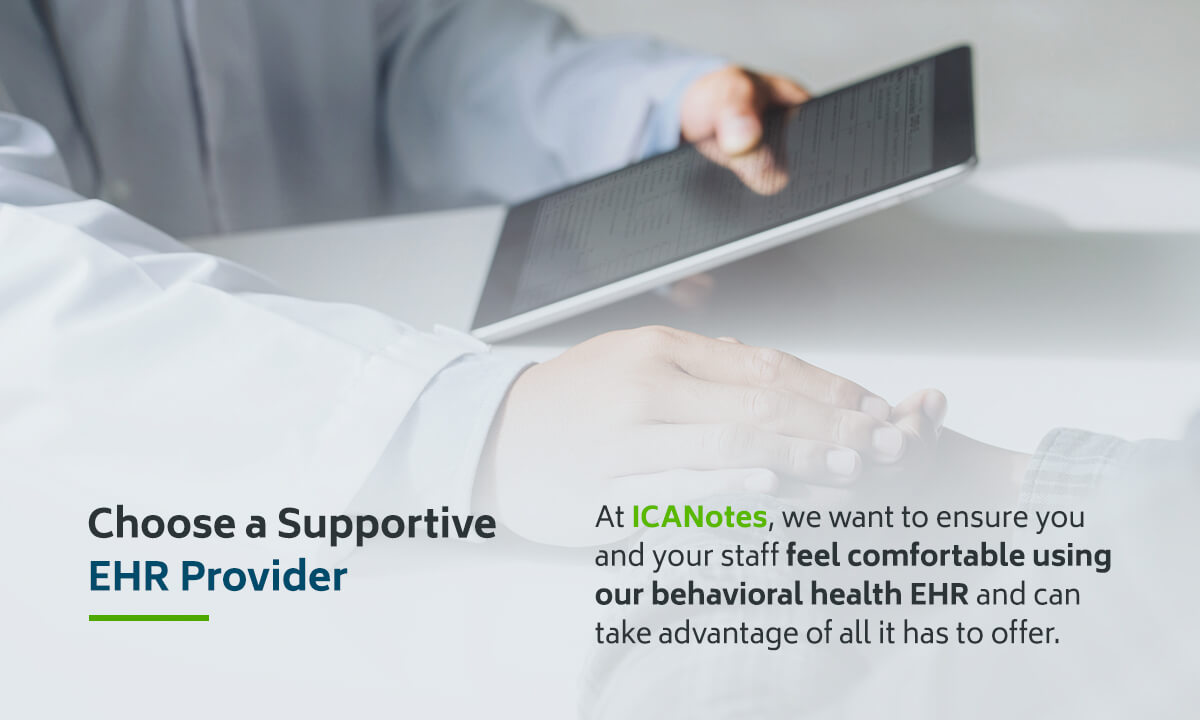The Importance of Support and Training Resources When Choosing an EHR Provider
Have you decided to implement new electronic health record (EHR) software in your behavioral and mental health practice? An EHR can help your practice stay organized, submit claims on time, coordinate care with other clinicians and streamline communication with clients and staff.
All of this is exciting news for your practice and clients. But to make the most of your EHR and get the maximum return, it's crucial that all users receive adequate training. Discover the benefits of EHR training for behavioral health professionals and best practices for a successful implementation below.
Table of Contents:
- Why Is EHR Training Important?
- The Benefits of EHR Training
- Understanding Different Training Strategies
- How to Create an EHR Training Plan
- EHR Training Best Practices
- Why It's Important to Choose a Supportive EHR Provider
Why Is EHR Training Important?
Training is one of the most vital aspects of EHR implementation because the software is only valuable if clinicians and staff know how to use it. Your EHR will have helpful features and customization options that you and your team can utilize to improve your practice's efficiency and deliver higher quality care. But you need to understand how to move through each step first.
If users do not know how to navigate the EHR, they're bound to feel frustrated or overlook time-saving features. Without proper EHR training, your practice is also at greater risk of costly and potentially dangerous documentation errors.
To illustrate the impact of EHR training, consider a study from 2018. Researchers explored how an intensive EHR training intervention affected physicians' skills and well-being. The study found that the training program led to improved documentation accuracy and quality of care, reduced medical errors and increased efficiency. Some physicians reported having a greater work-life balance as a result. The majority of study participants claimed they save four to five minutes an hour on documentation tasks after training, adding up to about an hour a day for some healthcare providers.
Despite its importance, many organizations do not give EHR training the attention it deserves. According to Applied Clinical Informatics, 43% of clinicians rated their initial EHR training as inadequate, and nearly 95% claimed they could improve their EHR skills. As you'll see, it's worth prioritizing EHR training in your practice for short-term and long-term benefits.
The Benefits of EHR Training
An EHR is a major investment that can help transform your practice into the modern and efficient office your clients envision. As more physicians adopt EHR technology, more patients expect the convenience of EHRs from other healthcare providers, such as easy access to their behavioral health records through a patient portal. Proper EHR training is key to giving your clients what they want and need. Here are more benefits of EHR training:
1. Recognize the EHR's Full Potential
Comprehensive EHR software offers countless ways to improve your practice. You can use your EHR to send automatic appointment reminders to clients, streamline billing processes and customize note-writing templates to meet your practice's needs. In other words, your EHR can save you time, money and frustration if you know how to use the system to its full potential.
By contrast, if you and your staff do not recognize what your EHR is capable of, many of its helpful features will go unused. Ensure your training program teaches users how to utilize features that are relevant to their roles to improve your practice overall.
2. Increase Documentation and Coding Accuracy
When clinicians do not receive adequate EHR training, they are more likely to make documentation errors, slowing productivity and putting clients' health at risk. According to a Journal of the American Medical Informatics Association (JAMIA) Open article, clinicians often make preventable errors when they don't receive sufficient training. As a result, they may need to spend extra time redoing or completing EHR tasks. In some cases, clinicians enter incorrect data or leave information missing, which can be harmful to the patient.
EHR training teaches healthcare providers how to write notes quickly and accurately to avoid mistakes, ensure records are complete and have more time with their patients. Understanding an EHR's automated coding functions can also help ensure accuracy when it's time to bill for services and get reimbursed.
3. Improve Efficiency and Productivity
An EHR is meant to improve workflow and increase productivity by centralizing patient data, reducing the need for manual data entry and enhancing communication between healthcare providers. If the staff does not know how to use the EHR, your practice can face inefficiencies and reduce the amount of time clinicians have with their clients. Plan an EHR training program to teach trainees how to overcome specific productivity challenges and use the software to complete documentation and billing tasks in minimal time.
4. See a Return on Your Investment for Years
Proper EHR training will provide the greatest return on your investment. And, if you offer ongoing training and support to ensure your staff continues to learn, you'll see this return for many years.
An EHR system offers increased operational efficiency, which can reduce costs for your practice. However, these savings only occur when implementation is done well. Thorough training is a necessary component of successful implementation.
5. Increase User Satisfaction
Not knowing how to use the EHR system can lead to frustration, stress and, ultimately, burnout. User dissatisfaction can also impact the quality of care clients receive.
According to an article published in Applied Clinical Informatics, clinicians who received less than four hours of EHR training reported having a frustrating experience with their system. Those clinicians were less likely to claim their EHR helps them deliver quality care. With each additional hour of training, users' overall satisfaction increased.
Proper training ensures therapists and staff are comfortable with the software and satisfied with their skills before applying them in the real world.
6. Boost Morale
You and your colleagues should not have to dread using the EHR. Instead, you should feel confident in your EHR skills and motivated to use your abilities to help your practice grow. Training gives you and your staff the necessary tools to feel in control and enthusiastic about the software's many features.
Understanding Different Training Strategies
To ensure EHR training is effective, organizations such as the California Health Care Foundation recommend using one or more of the following training strategies:
- Identify and train super users: Select a group of staff members to get trained by your EHR vendor and be "super users." Super users are fully trained on the EHR's functions and can offer ongoing support and training to other staff members. Super users should be easily accessible, willing to serve as mentors, highly computer literate and enthusiastic about implementation.
- Offer role-based training: Every staff member does not need to be an expert on every EHR function. A licensed professional counselor needs to know how to write progress notes in the EHR, but they won't need to use an e-prescribing function. Although each staff member might familiarize themselves with all of the EHR's capabilities, they should only focus on areas that'll help them do their jobs. Role-based training teaches users only what they need to know to succeed in the day to day.
- Provide process-based training: Your EHR will change your practice's workflow. For instance, your EHR might change how you communicate with clients or schedule appointments. Process-based training teaches staff about new workflows and ensures everyone is on the same page. To provide process training, you might close your practice for a day and let staff members rehearse their roles. Supervisors can act as clients so staff can experience using the EHR from check-in to check-out.
How to Create an EHR Training Plan
A training plan describes how you will deliver training and ensure staff members learn new skills. Your plan should also include training goals and a timeline for reaching these goals. Here are steps to creating a training plan tailored to your practice's needs:
- Consider users' skills and learning styles: Assess each user's computer skills and consider whether they are comfortable with new technology. If staff members need to sharpen their PC abilities, think of how you'll help them develop basic computer skills. Plan to incorporate coursework that'll effectively reach trainees with different learning styles. For example, you might combine visual learning with verbal instruction.
- Establish training goals: Describe your plan's purpose and establish goals for staff members regarding EHR use. You might set a goal for therapists to get comfortable using note-writing templates one week and teach them how to use the telehealth platform the next. Overall, you'll want to establish short-term and long-term training goals.
- Determine how you'll deliver training: Explain the techniques and strategies you'll use to provide training. Include what materials and resources you'll offer to trainees, as well. Your EHR vendor should have plenty of training resources to help you and your staff learn the software. You'll also need to create training materials to address your practice's specific needs.
- Figure out how many people you'll train and when: Determine other training details, such as how many people you'll train and when. Try to accommodate different schedules and group staff members who share the same roles or workflows. Note that some staff members may require more training hours than others depending on how they'll use the EHR.
- Decide where you'll hold training classes: If training does not occur in your office, try to choose a location as close to your practice as possible. Ensure the setting is quiet and ergonomic with comfortable workstations. You might also provide training courses online.
- Create a timeline: The most critical part of training is ensuring trainees have enough time to learn how to use the EHR. Researchers recommend offering training classes two to eight weeks before implementation. However, super users should begin training months in advance. You may also want to hold refresher courses a few days before going live. Be sure to include training goals in your timeline.
EHR Training Best Practices
EHR training and implementation can be successful if you plan ahead and keep best practices in mind. Here are a few points to remember:
- Include hands-on practice: Make sure to offer a variety of role-based lessons that include hands-on practice along with computer-based training and workflow rehearsals. You'll also want to ensure staff members clearly understand their roles in the new workflow.
- Collaborate with leaders to choose training content and revise policies: Work with your vendor and clinicians in leadership roles to determine the training curriculum. Be sure to update your practice's policies to reflect the new workflows and EHR features, such as template customization. You may wish to create a policy that does not allow users to access the EHR until they've received adequate training.
- Provide document training: Keep a record of the training process and related costs. Make sure you have a way to track each user's training status, as well.
- Offer ongoing training: EHR training should continue after you go live. Ensure employees have easy access to training resources in the future so they can sharpen their EHR skills whenever they need to. Keep in mind that you may need to offer future training to prepare staff for EHR upgrades or updates.
- Move at the right pace: EHR implementation should move at a pace you and your team are comfortable with. It's crucial for staff to have basic computer skills and other essential competencies before moving ahead with implementation.
- Use your vendor's resources: Your EHR vendor should be available to help you train employees by offering training resources and support. They should also be willing to customize training to meet your needs.
Why It's Important to Choose a Supportive EHR Provider
[embedyt] https://www.youtube.com/watch?v=f6FuCgHx4iU[/embedyt]
No one knows your EHR software better than your provider. It's critical to work with a reliable and qualified vendor that provides implementation training, plentiful resources and exceptional, ongoing support. It's also essential to choose a provider that's easy to reach, returns your calls and answers your questions promptly. Overall, your vendor should be excited to help you learn their system and use it to its full potential.
At ICANotes, we want to ensure you and your staff feel comfortable using our behavioral health EHR and can take advantage of all it has to offer. Our customers have access to free individual online training sessions, training webinars, video tutorials and user guides. Plus, our knowledgeable support agents are available to help you through live chat, phone or email.
Training is more than knowing how to write notes in an EHR — it's about using the program to improve patient care and increase your practice's efficiency. We understand that adequate training can seem easier said than done, but we're here for you to help the process go smoothly. If you're ready to learn more about our EHR training for therapists, psychologists, psychiatrists and other behavioral health professionals, please contact us today.
Related Posts:
Biggest Challenges Behavioral Health Clinicians Will Face in 2021
Top 5 Reasons Behavioral Health Professionals Get Sued
Sources
- https://www.ncbi.nlm.nih.gov/pmc/articles/PMC6160120/
- https://www.ncbi.nlm.nih.gov/pmc/articles/PMC4377562/
- https://dashboard.healthit.gov/quickstats/pages/physician-ehr-adoption-trends.php
- https://academic.oup.com/jamiaopen/article/1/2/142/5074118
- https://www.healthit.gov/topic/health-it-and-health-information-exchange-basics/medical-practice-efficiencies-cost-savings
- https://www.thieme-connect.com/products/ejournals/html/10.1055/s-0039-1688753
- https://www.chcf.org/wp-content/uploads/2017/12/PDF-TrainingStrategiesEHRDeployment.pdf

